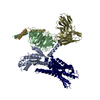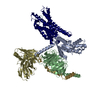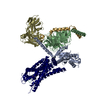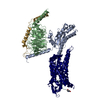+ データを開く
データを開く
- 基本情報
基本情報
| 登録情報 | データベース: PDB / ID: 8xzg | |||||||||
|---|---|---|---|---|---|---|---|---|---|---|
| タイトル | Cryo-EM structure of the [Pyr1]-apelin-13-bound human APLNR-Gi complex | |||||||||
 要素 要素 |
| |||||||||
 キーワード キーワード |  MEMBRANE PROTEIN (膜タンパク質) / APLNR / apelin / Class A GPCR / MEMBRANE PROTEIN (膜タンパク質) / APLNR / apelin / Class A GPCR /  Structural protein (タンパク質) Structural protein (タンパク質) | |||||||||
| 機能・相同性 |  機能・相同性情報 機能・相同性情報 apelin receptor binding / positive regulation of G protein-coupled receptor internalization / apelin receptor binding / positive regulation of G protein-coupled receptor internalization /  apelin receptor activity / apelin receptor signaling pathway / apelin receptor activity / apelin receptor signaling pathway /  regulation of gap junction assembly / positive regulation of inhibitory G protein-coupled receptor phosphorylation / vascular associated smooth muscle cell differentiation / atrioventricular valve development / regulation of body fluid levels / venous blood vessel development ... regulation of gap junction assembly / positive regulation of inhibitory G protein-coupled receptor phosphorylation / vascular associated smooth muscle cell differentiation / atrioventricular valve development / regulation of body fluid levels / venous blood vessel development ... apelin receptor binding / positive regulation of G protein-coupled receptor internalization / apelin receptor binding / positive regulation of G protein-coupled receptor internalization /  apelin receptor activity / apelin receptor signaling pathway / apelin receptor activity / apelin receptor signaling pathway /  regulation of gap junction assembly / positive regulation of inhibitory G protein-coupled receptor phosphorylation / vascular associated smooth muscle cell differentiation / atrioventricular valve development / regulation of body fluid levels / venous blood vessel development / negative regulation of fibroblast growth factor receptor signaling pathway / positive regulation of heart contraction / regulation of gap junction assembly / positive regulation of inhibitory G protein-coupled receptor phosphorylation / vascular associated smooth muscle cell differentiation / atrioventricular valve development / regulation of body fluid levels / venous blood vessel development / negative regulation of fibroblast growth factor receptor signaling pathway / positive regulation of heart contraction /  急性アルコール中毒 / positive regulation of blood vessel endothelial cell proliferation involved in sprouting angiogenesis / endocardial cushion formation / adult heart development / coronary vasculature development / vasculature development / negative regulation of cAMP-mediated signaling / aorta development / positive regulation of vascular endothelial cell proliferation / ventricular septum morphogenesis / heart looping / blood vessel development / negative regulation of vascular associated smooth muscle cell proliferation / Adenylate cyclase inhibitory pathway / 急性アルコール中毒 / positive regulation of blood vessel endothelial cell proliferation involved in sprouting angiogenesis / endocardial cushion formation / adult heart development / coronary vasculature development / vasculature development / negative regulation of cAMP-mediated signaling / aorta development / positive regulation of vascular endothelial cell proliferation / ventricular septum morphogenesis / heart looping / blood vessel development / negative regulation of vascular associated smooth muscle cell proliferation / Adenylate cyclase inhibitory pathway /  gastrulation / positive regulation of protein localization to cell cortex / regulation of cAMP-mediated signaling / gastrulation / positive regulation of protein localization to cell cortex / regulation of cAMP-mediated signaling /  脈管形成 / D2 dopamine receptor binding / G protein-coupled serotonin receptor binding / regulation of mitotic spindle organization / cellular response to forskolin / adenylate cyclase-inhibiting G protein-coupled receptor signaling pathway / negative regulation of blood pressure / 脈管形成 / D2 dopamine receptor binding / G protein-coupled serotonin receptor binding / regulation of mitotic spindle organization / cellular response to forskolin / adenylate cyclase-inhibiting G protein-coupled receptor signaling pathway / negative regulation of blood pressure /  授乳 / Peptide ligand-binding receptors / positive regulation of release of sequestered calcium ion into cytosol / Regulation of insulin secretion / G protein-coupled receptor binding / G protein-coupled receptor activity / Olfactory Signaling Pathway / G-protein beta/gamma-subunit complex binding / Activation of the phototransduction cascade / G beta:gamma signalling through PLC beta / Presynaptic function of Kainate receptors / Thromboxane signalling through TP receptor / adenylate cyclase-modulating G protein-coupled receptor signaling pathway / G-protein activation / G protein-coupled acetylcholine receptor signaling pathway / Activation of G protein gated Potassium channels / Inhibition of voltage gated Ca2+ channels via Gbeta/gamma subunits / Prostacyclin signalling through prostacyclin receptor / Glucagon signaling in metabolic regulation / G beta:gamma signalling through CDC42 / 授乳 / Peptide ligand-binding receptors / positive regulation of release of sequestered calcium ion into cytosol / Regulation of insulin secretion / G protein-coupled receptor binding / G protein-coupled receptor activity / Olfactory Signaling Pathway / G-protein beta/gamma-subunit complex binding / Activation of the phototransduction cascade / G beta:gamma signalling through PLC beta / Presynaptic function of Kainate receptors / Thromboxane signalling through TP receptor / adenylate cyclase-modulating G protein-coupled receptor signaling pathway / G-protein activation / G protein-coupled acetylcholine receptor signaling pathway / Activation of G protein gated Potassium channels / Inhibition of voltage gated Ca2+ channels via Gbeta/gamma subunits / Prostacyclin signalling through prostacyclin receptor / Glucagon signaling in metabolic regulation / G beta:gamma signalling through CDC42 /  hormone activity / ADP signalling through P2Y purinoceptor 12 / G beta:gamma signalling through BTK / Synthesis, secretion, and inactivation of Glucagon-like Peptide-1 (GLP-1) / Sensory perception of sweet, bitter, and umami (glutamate) taste / photoreceptor disc membrane / response to peptide hormone / Adrenaline,noradrenaline inhibits insulin secretion / Glucagon-type ligand receptors / Vasopressin regulates renal water homeostasis via Aquaporins / G alpha (z) signalling events / cellular response to catecholamine stimulus / Glucagon-like Peptide-1 (GLP1) regulates insulin secretion / ADORA2B mediated anti-inflammatory cytokines production / positive regulation of miRNA transcription / adenylate cyclase-activating dopamine receptor signaling pathway / ADP signalling through P2Y purinoceptor 1 / G beta:gamma signalling through PI3Kgamma / cellular response to prostaglandin E stimulus / Cooperation of PDCL (PhLP1) and TRiC/CCT in G-protein beta folding / sensory perception of taste / GPER1 signaling / G-protein beta-subunit binding / GDP binding / positive regulation of angiogenesis / Inactivation, recovery and regulation of the phototransduction cascade / hormone activity / ADP signalling through P2Y purinoceptor 12 / G beta:gamma signalling through BTK / Synthesis, secretion, and inactivation of Glucagon-like Peptide-1 (GLP-1) / Sensory perception of sweet, bitter, and umami (glutamate) taste / photoreceptor disc membrane / response to peptide hormone / Adrenaline,noradrenaline inhibits insulin secretion / Glucagon-type ligand receptors / Vasopressin regulates renal water homeostasis via Aquaporins / G alpha (z) signalling events / cellular response to catecholamine stimulus / Glucagon-like Peptide-1 (GLP1) regulates insulin secretion / ADORA2B mediated anti-inflammatory cytokines production / positive regulation of miRNA transcription / adenylate cyclase-activating dopamine receptor signaling pathway / ADP signalling through P2Y purinoceptor 1 / G beta:gamma signalling through PI3Kgamma / cellular response to prostaglandin E stimulus / Cooperation of PDCL (PhLP1) and TRiC/CCT in G-protein beta folding / sensory perception of taste / GPER1 signaling / G-protein beta-subunit binding / GDP binding / positive regulation of angiogenesis / Inactivation, recovery and regulation of the phototransduction cascade /  heterotrimeric G-protein complex / G alpha (12/13) signalling events / heterotrimeric G-protein complex / G alpha (12/13) signalling events /  extracellular vesicle / signaling receptor complex adaptor activity / Thrombin signalling through proteinase activated receptors (PARs) / retina development in camera-type eye / extracellular vesicle / signaling receptor complex adaptor activity / Thrombin signalling through proteinase activated receptors (PARs) / retina development in camera-type eye /  signaling receptor activity / signaling receptor activity /  GTPase binding / Ca2+ pathway / phospholipase C-activating G protein-coupled receptor signaling pathway / GTPase binding / Ca2+ pathway / phospholipase C-activating G protein-coupled receptor signaling pathway /  細胞皮質 / 細胞皮質 /  heart development / midbody / G alpha (i) signalling events / fibroblast proliferation / G alpha (s) signalling events / G alpha (q) signalling events / heart development / midbody / G alpha (i) signalling events / fibroblast proliferation / G alpha (s) signalling events / G alpha (q) signalling events /  遺伝子発現の調節 遺伝子発現の調節類似検索 - 分子機能 | |||||||||
| 生物種 |   Homo sapiens (ヒト) Homo sapiens (ヒト) | |||||||||
| 手法 |  電子顕微鏡法 / 電子顕微鏡法 /  単粒子再構成法 / 単粒子再構成法 /  クライオ電子顕微鏡法 / 解像度: 3.2 Å クライオ電子顕微鏡法 / 解像度: 3.2 Å | |||||||||
 データ登録者 データ登録者 | Wang, W. / Ji, S. / Zhang, Y. | |||||||||
| 資金援助 |  中国, 2件 中国, 2件
| |||||||||
 引用 引用 |  ジャーナル: Cell / 年: 2024 ジャーナル: Cell / 年: 2024タイトル: Structure-based design of non-hypertrophic apelin receptor modulator. 著者: Wei-Wei Wang / Su-Yu Ji / Wenjia Zhang / Junxia Zhang / Chenxi Cai / Rubi Hu / Shao-Kun Zang / Luwei Miao / Haomang Xu / Li-Nan Chen / Zongkuai Yang / Jia Guo / Jiao Qin / Dan-Dan Shen / Ping ...著者: Wei-Wei Wang / Su-Yu Ji / Wenjia Zhang / Junxia Zhang / Chenxi Cai / Rubi Hu / Shao-Kun Zang / Luwei Miao / Haomang Xu / Li-Nan Chen / Zongkuai Yang / Jia Guo / Jiao Qin / Dan-Dan Shen / Ping Liang / Yan Zhang / Yan Zhang /  要旨: Apelin is a key hormone in cardiovascular homeostasis that activates the apelin receptor (APLNR), which is regarded as a promising therapeutic target for cardiovascular disease. However, adverse ...Apelin is a key hormone in cardiovascular homeostasis that activates the apelin receptor (APLNR), which is regarded as a promising therapeutic target for cardiovascular disease. However, adverse effects through the β-arrestin pathway limit its pharmacological use. Here, we report cryoelectron microscopy (cryo-EM) structures of APLNR-G complexes bound to three agonists with divergent signaling profiles. Combined with functional assays, we have identified "twin hotspots" in APLNR as key determinants for signaling bias, guiding the rational design of two exclusive G-protein-biased agonists WN353 and WN561. Cryo-EM structures of WN353- and WN561-stimulated APLNR-G protein complexes further confirm that the designed ligands adopt the desired poses. Pathophysiological experiments have provided evidence that WN561 demonstrates superior therapeutic effects against cardiac hypertrophy and reduced adverse effects compared with the established APLNR agonists. In summary, our designed APLNR modulator may facilitate the development of next-generation cardiovascular medications. | |||||||||
| 履歴 |
|
- 構造の表示
構造の表示
| 構造ビューア | 分子:  Molmil Molmil Jmol/JSmol Jmol/JSmol |
|---|
- ダウンロードとリンク
ダウンロードとリンク
- ダウンロード
ダウンロード
| PDBx/mmCIF形式 |  8xzg.cif.gz 8xzg.cif.gz | 176.2 KB | 表示 |  PDBx/mmCIF形式 PDBx/mmCIF形式 |
|---|---|---|---|---|
| PDB形式 |  pdb8xzg.ent.gz pdb8xzg.ent.gz | 133.8 KB | 表示 |  PDB形式 PDB形式 |
| PDBx/mmJSON形式 |  8xzg.json.gz 8xzg.json.gz | ツリー表示 |  PDBx/mmJSON形式 PDBx/mmJSON形式 | |
| その他 |  その他のダウンロード その他のダウンロード |
-検証レポート
| アーカイブディレクトリ |  https://data.pdbj.org/pub/pdb/validation_reports/xz/8xzg https://data.pdbj.org/pub/pdb/validation_reports/xz/8xzg ftp://data.pdbj.org/pub/pdb/validation_reports/xz/8xzg ftp://data.pdbj.org/pub/pdb/validation_reports/xz/8xzg | HTTPS FTP |
|---|
-関連構造データ
| 関連構造データ |  38795MC  8xzfC  8xzhC  8xziC  8xzjC M: このデータのモデリングに利用したマップデータ C: 同じ文献を引用 ( |
|---|---|
| 類似構造データ | 類似検索 - 機能・相同性  F&H 検索 F&H 検索 |
- リンク
リンク
- 集合体
集合体
| 登録構造単位 | 
|
|---|---|
| 1 |
|
- 要素
要素
| #1: タンパク質 | 分子量: 40414.047 Da / 分子数: 1 / 由来タイプ: 組換発現 / 由来: (組換発現)   Homo sapiens (ヒト) / 遺伝子: GNAI1 / Cell (発現宿主): Sf9 Homo sapiens (ヒト) / 遺伝子: GNAI1 / Cell (発現宿主): Sf9発現宿主:   Spodoptera frugiperda (ツマジロクサヨトウ) Spodoptera frugiperda (ツマジロクサヨトウ)参照: UniProt: P63096 |
|---|---|
| #2: タンパク質 | 分子量: 37285.734 Da / 分子数: 1 / 由来タイプ: 組換発現 / 由来: (組換発現)   Homo sapiens (ヒト) / 遺伝子: GNB1 / Cell (発現宿主): Sf9 Homo sapiens (ヒト) / 遺伝子: GNB1 / Cell (発現宿主): Sf9発現宿主:   Spodoptera frugiperda (ツマジロクサヨトウ) Spodoptera frugiperda (ツマジロクサヨトウ)参照: UniProt: P62873 |
| #3: タンパク質 | 分子量: 7861.143 Da / 分子数: 1 / 由来タイプ: 組換発現 / 由来: (組換発現)   Homo sapiens (ヒト) / 遺伝子: GNG2 / Cell (発現宿主): Sf9 Homo sapiens (ヒト) / 遺伝子: GNG2 / Cell (発現宿主): Sf9発現宿主:   Spodoptera frugiperda (ツマジロクサヨトウ) Spodoptera frugiperda (ツマジロクサヨトウ)参照: UniProt: P59768 |
| #4: タンパク質・ペプチド | 分子量: 1537.830 Da / 分子数: 1 / 由来タイプ: 組換発現 / 由来: (組換発現)   Homo sapiens (ヒト) / 遺伝子: APLN, APEL / 発現宿主: Homo sapiens (ヒト) / 遺伝子: APLN, APEL / 発現宿主:   Homo sapiens (ヒト) / 参照: UniProt: Q9ULZ1 Homo sapiens (ヒト) / 参照: UniProt: Q9ULZ1 |
| #5: タンパク質 |  / Angiotensin receptor-like 1 / G-protein coupled receptor APJ / G-protein coupled receptor HG11 / Angiotensin receptor-like 1 / G-protein coupled receptor APJ / G-protein coupled receptor HG11分子量: 42696.301 Da / 分子数: 1 / 由来タイプ: 組換発現 / 由来: (組換発現)   Homo sapiens (ヒト) / 遺伝子: APLNR, AGTRL1, APJ / Cell (発現宿主): Sf9 Homo sapiens (ヒト) / 遺伝子: APLNR, AGTRL1, APJ / Cell (発現宿主): Sf9発現宿主:   Spodoptera frugiperda (ツマジロクサヨトウ) Spodoptera frugiperda (ツマジロクサヨトウ)参照: UniProt: P35414 |
| 研究の焦点であるリガンドがあるか | N |
-実験情報
-実験
| 実験 | 手法:  電子顕微鏡法 電子顕微鏡法 |
|---|---|
| EM実験 | 試料の集合状態: PARTICLE / 3次元再構成法:  単粒子再構成法 単粒子再構成法 |
- 試料調製
試料調製
| 構成要素 | 名称: Cryo-EM structure of the [Pyr1]-apelin-13-bound human APLNR-Gi complex タイプ: COMPLEX / Entity ID: all / 由来: RECOMBINANT |
|---|---|
| 由来(天然) | 生物種:   Homo sapiens (ヒト) Homo sapiens (ヒト) |
| 由来(組換発現) | 生物種:   Spodoptera frugiperda (ツマジロクサヨトウ) Spodoptera frugiperda (ツマジロクサヨトウ) |
| 緩衝液 | pH: 7.5 |
| 試料 | 濃度: 15 mg/ml / 包埋: NO / シャドウイング: NO / 染色 : NO / 凍結 : NO / 凍結 : YES : YES |
| 試料支持 | グリッドの材料: GOLD / グリッドのサイズ: 300 divisions/in. / グリッドのタイプ: Quantifoil R1.2/1.3 |
急速凍結 | 凍結剤: ETHANE |
- 電子顕微鏡撮影
電子顕微鏡撮影
| 実験機器 |  モデル: Titan Krios / 画像提供: FEI Company |
|---|---|
| 顕微鏡 | モデル: FEI TITAN KRIOS |
| 電子銃 | 電子線源 : :  FIELD EMISSION GUN / 加速電圧: 300 kV / 照射モード: FLOOD BEAM FIELD EMISSION GUN / 加速電圧: 300 kV / 照射モード: FLOOD BEAM |
| 電子レンズ | モード: BRIGHT FIELD Bright-field microscopy / 最大 デフォーカス(公称値): 2500 nm / 最小 デフォーカス(公称値): 1000 nm / Cs Bright-field microscopy / 最大 デフォーカス(公称値): 2500 nm / 最小 デフォーカス(公称値): 1000 nm / Cs : 2.7 mm : 2.7 mm |
| 撮影 | 電子線照射量: 62.4 e/Å2 フィルム・検出器のモデル: GATAN K2 SUMMIT (4k x 4k) |
- 解析
解析
CTF補正 | タイプ: PHASE FLIPPING AND AMPLITUDE CORRECTION | ||||||||||||||||||||||||
|---|---|---|---|---|---|---|---|---|---|---|---|---|---|---|---|---|---|---|---|---|---|---|---|---|---|
| 粒子像の選択 | 選択した粒子像数: 2703505 | ||||||||||||||||||||||||
3次元再構成 | 解像度: 3.2 Å / 解像度の算出法: FSC 0.143 CUT-OFF / 粒子像の数: 201936 / 対称性のタイプ: POINT | ||||||||||||||||||||||||
| 拘束条件 |
|
 ムービー
ムービー コントローラー
コントローラー







 PDBj
PDBj





























